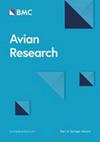朱鹮蜕皮与繁殖的权衡在管理中的应用
IF 1.7
2区 生物学
Q1 ORNITHOLOGY
引用次数: 0
摘要
换羽是鸟类年度循环的重要事件。鸟类的换羽模式和策略对于了解它们的生活史权衡和适应环境至关重要。然而,由于数据收集困难,许多东部古北地区的鸟类,特别是大型濒危物种的换羽知识仍然缺乏。本文采用非侵入性野外摄影技术,对濒危朱鹮(Nipponia nippon)的换羽情况进行了检测和评分,并探讨了其换羽时间的变化和换羽繁殖的权衡。成年朱鹮从4月到10月,依次从三个地点向外蜕初级毛,向内蜕次级毛。年龄(成虫与亚成虫)和繁殖状态(是否繁殖)对换羽时间有显著影响。换毛时间在两性之间没有差异,可能是因为父母在繁殖方面的投资相似。朱鹮表现出明显的换羽重叠,因为换羽是有时间限制的,需要在冬季食物短缺的季节之前完成。繁殖时间(首产蛋日期)对换羽时间有很大影响,较晚的繁殖者换羽时间较长,这表明在繁殖期间,由于换羽和繁殖之间的权衡,换羽强度减慢。这反映了在长时间的换羽重叠期间,后期繁殖者的能量分配是具有挑战性的,这可能在一定程度上导致了它们的高繁殖失败率。我们的研究结果强烈表明,繁殖时间与适合度和换羽之间存在负相关关系:早期繁殖者的繁殖产量较高,羽毛质量较高,而晚期繁殖者的繁殖产量较低,羽毛质量较差。本文章由计算机程序翻译,如有差异,请以英文原文为准。
Moult-breeding trade-offs in the Crested Ibis (Nipponia nippon) could have management applications
Moult is an essential event in the annual cycle of birds. Moult patterns and strategies of birds are crucial for understanding their life-history trade-offs and adaptations to the environment. However, moult knowledge is still lacking for many Eastern Palaearctic birds, especially large endangered species, mainly because of the difficulty in data collection. Here, we used field photography, a non-invasive method, to detect and score moult in the endangered Crested Ibis (Nipponia nippon) and explored the moult timing variations and moult-breeding trade-offs. The adult Crested Ibis sequentially moults its primaries outward, and secondaries inward from three foci from April to October. Age (adult versus sub-adult) and breeding status (breeding or not) have a significant effect on moult timing. Moult timing does not differ between the sexes, likely because of similar parental investments in breeding. Crested Ibis exhibits significant moult-breeding overlap, because moult is time constrained and needs to finish before the season of food scarcity in winter. Breeding timing (first egg laying date) has a strong impact on moult duration, with late breeders experiencing a longer moult duration, indicating that the moult intensity is slowed down during the breeding period because of trade-offs between moult and breeding. This reflects that energy allocation of late breeders is challenging during extensive periods of moult-breeding overlap, which might partly contribute to their high breeding failure. Our results strongly suggest the existence of a negative relationship between breeding time on one hand, and fitness and moult on the other: early breeders show higher reproductive output and higher quality plumage, whereas late breeders show lower reproductive output and lower quality plumage.
求助全文
通过发布文献求助,成功后即可免费获取论文全文。
去求助
来源期刊

Avian Research
ORNITHOLOGY-
CiteScore
2.90
自引率
16.70%
发文量
456
审稿时长
46 days
期刊介绍:
Avian Research is an open access, peer-reviewed journal publishing high quality research and review articles on all aspects of ornithology from all over the world. It aims to report the latest and most significant progress in ornithology and to encourage exchange of ideas among international ornithologists. As an open access journal, Avian Research provides a unique opportunity to publish high quality contents that will be internationally accessible to any reader at no cost.
 求助内容:
求助内容: 应助结果提醒方式:
应助结果提醒方式:


